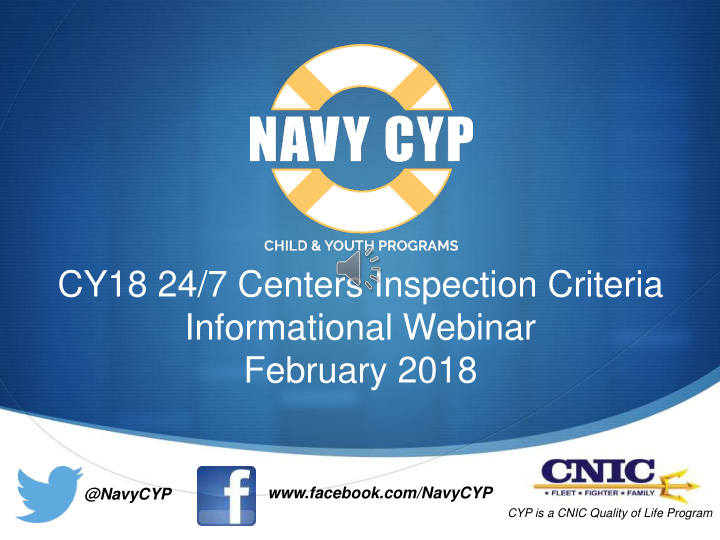



CY18 24/7 Centers Inspection Criteria Informational Webinar February 2018 www.facebook.com/NavyCYP @NavyCYP CYP is a CNIC Quality of Life Program
Housekeeping • Available for download: • Slides and script • CY18 Inspection Criteria • Email your questions to Deborah.Enright@navy.mil • A Q&A document will be uploaded to the CYP e-Library.
Agenda Overview of Criteria New Inspection Components Program Notes Combined, Separated and Updated Components Environments Programming
Overview of CY18 Inspection Criteria • CY18 Criteria Sets • CDC Inspection Criteria CNICCYP 1700/33 • CYP Inspection Criteria CNICCYP 1700/32 • CDH (FCC) Inspection Criteria CNICCYP 1700/34 • 24-7 Centers Inspection Criteria CNICCYP 1700/35 • Type III Inspection Criteria CNICCYP 1700/36 • SAC Inspection Criteria CNICCYP 1700/38A • YP Inspection Criteria CNICCYP 1700/38B • SAC-YP Inspection Criteria CNICCYP 1700/38C • Trips and Tours Inspection Criteria CNICCYP 1700/38D
New Inspection Criteria New Inspection Criteria • B.10.a.8 – Children/Youth self-release with parent permission • C.3.a.2 – Direct care staff interact responsively with other staff
Background Checks Most background check inspection criteria is now located within the CYP Inspection Criteria -- CNICCYP 1700/32.
Program Notes Program Notes Feature • CNIC is now using the “Program Notes” feature of the IMS to communicate policy, CYMS training codes, training web links, core program area intent statements, etc. to the field. C.1.b.5 CYP Professionals are responsive to families Program Notes: 24/7 Centers: Examples of staff demonstrating responsive interactions families may include: staff use a warm tone - their words and body language lack anger or frustration; facial expressions and body language are happy/calm, or matches family member’s affect to show concern; ask families for information and share information about their children and program activities; use family members’ names; greet family members when they enter program space.
Combined Components • C.3.g.2 – CYP Professionals provide materials, routines and an environment that supports the five domains (Infants, Pretoddlers, and Toddlers) • C.3.g.4 – CYP Professionals provide materials, routines and an environment that supports the eight domains (Preschool) • C.3.g.6 - CYP Professionals provide opportunities for learning outdoors
Components Separated • A.2.b.4 Staffing within classrooms/programs remains consistent • A.3.c.1 CYP Professionals complete orientation training • B.6.a.7 Rooms/program space are maintained at a comfortable temperature • C.3.g.5 Environments are organized and materials are accessible
Updated Components • C.3.d.2 CYP Professionals create portfolios for each child • C.3.g.1 CYP Professionals staff plan/implement activities for infants, pretoddlers and toddlers that support the five domains • C.3.g.3 CYP Professionals plan/implement activities for preschoolers that support the eight domains
Environments Center or Home?? S
24/7 Centers should be set up like… a home
24/7 Environments • C.3.g.2 CYP Professionals provide materials, routines and an environment that supports the five domains • C.3.g.4 CYP Professionals provide materials, routines and an environment that supports the eight domains
What are the Inspectors looking for? • Is the environment welcoming to children and families? • Is the greeting area welcoming or cluttered? Does it make sense where it is located? • Are noisy and quiet spaces separated? • Are areas of the environment defined so children know where they can play and what is off limits? • Do school age children have space to play and work uninterrupted? • Are infants corralled and not included in the program community?
Center or Home?
Center or Home?
Questions?
Curriculum, VLS and Accreditation • 24/7 Centers use The Creative Curriculum for Family Child Care, 2 nd Edition • 24/7 Centers will use the FCC Virtual Lab School courses • 24/7 Centers are now required and eligible to be accredited through NAEYC
What is a “Domain”? • The term “Domain” is used to describe areas of development and learning in children. The 24/7 Center Inspection Criteria separates these by age groups • Five domains for infants, pretoddlers, and toddlers • Eight domains for preschool children
How are we meeting these components? While the terms may be different – if you are using the Creative Curriculum for Family Child Care and GOLD Assessment system, you are meeting the “ d omains” required in the Inspection Criteria.
Domains Infant, Pretoddler, Toddler Preschool • • Social-Emotional Social-emotional • • Self-Regulation Self-regulation • • Cognition, Communication • • Communication and Physical & health language, • Language & Literacy • Physical and health • Creative expression, • Science, • Math, • Social studies
Creative Curriculum • Objectives and Social Dimensions • Social – Emotional Emotion • 1. Regulates own emotions and behaviors Social-Emotional Domain • 2. Establishes and sustains positive relationships • 3. Participates cooperatively and constructively in group situations
Creative Curriculum • Objectives and Self- Dimensions • Social – Emotional Regulation • 1. Regulates own emotions and behaviors Self-Regulation • 2. Establishes and sustains positive relationships • 3. Participates cooperatively and constructively in group situations
Creative Curriculum • Objectives and Dimensions Creative • Cognitive Expression • 11. Demonstrates positive approaches to learning , • 12 Remembers and connect experiences • 13. Uses classification skills • 14 Uses symbols and images to represent something not present
Closing • All CY18 Inspection documents can be found on the CYP e-Library. • Email your questions to deborah.enright@navy.mil. THANK YOU FOR PARTICIPATING!
Recommend
More recommend